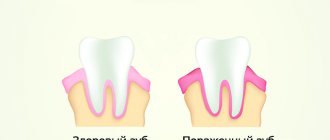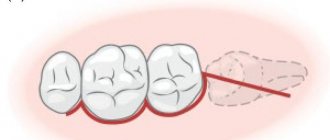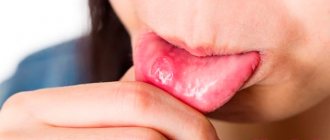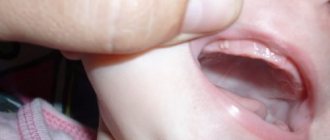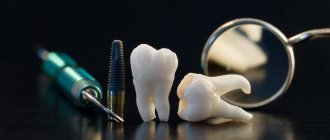Can a fever be caused by a wisdom tooth?
Patients faced with this problem often have a question: can a wisdom tooth produce fever during normal eruption? This shouldn't happen. An increase in general body temperature indicates complicated tooth emergence, which is a common situation that occurs in approximately 90% of people.
As the molar cuts through the gum tissue, it injures it. At this site, a local inflammatory process occurs, manifested by a feeling of heat on the gum. General body temperature remains normal.
If hyperthermia occurs, we can talk about the norm for this situation when the thermometer shows 37.0–38.0 ° C. The symptom usually persists until the crown of the molar appears above the gum, and sometimes within 2–3 days after that.
Could a temperature from a wisdom tooth be a sign of a pathology that requires medical intervention? This is also possible. The problem is indicated by an increase in temperature above 38.0° C. Among the pathological causes of hyperthermia during the eruption of the third molar are: abnormal direction of tooth growth, pericoronitis (suppuration of the gingival hood), and the addition of a bacterial infection.
Symptoms that many patients feel:
· Sore gums. This happens because the sharp edges of the coronal part press on the mucous membrane, causing irritation. If the tooth grows without complications, the pain will be dull and tolerable. But if the negative sensations are strong and constant, then we are talking about the development of an inflammatory process, and in this case it is necessary to urgently visit a doctor;
- Swelling and heaviness.
This is a complication in which the gum hangs over part of an already erupted tooth;
- Fever without signs of a cold
– this is a serious symptom that indicates that the process is complicated and the help of a doctor is needed;
- Heaviness in the chewing muscles
, which complicates the opening and closing of the oral cavity;
- Pain when swallowing indicates the development of a purulent abscess.
Associated symptoms
In addition to the increase in temperature, gum injury caused by tooth eruption is accompanied by a number of other characteristic signs. They make it possible to distinguish this physiological process from acute respiratory viral infections, tonsillitis and other diseases.
Symptoms accompanying the eruption of wisdom teeth:
- redness of the gums at the site where the molar is supposed to appear;
- It's a dull pain;
- local swelling of the gums;
- discomfort when chewing.
These signs are usually observed in combination. Sometimes they are accompanied by a sore throat, which is why patients may suspect they have a cold, but, unlike ARVI, the growth of a molar causes discomfort only on one side. This sign is more typical for the eruption of lower teeth. As the upper molars grow, ear pain may occur.
The listed manifestations, as well as pain in the lymph nodes located near the erupting tooth, may be normal. However, if they persist for a long time or tend to worsen, consulting a doctor is still necessary.
There are other alarming symptoms that cannot be ignored. If the pain has become sharp, unbearable and spreads to the temple, twitching of the facial muscles appears, the cheek is swollen, opening the mouth is difficult, an unpleasant taste is felt, pus is released from the gums - urgent medical attention is needed.
Peculiarities
In principle, “eights,” as dentists call them, are no different from other molars. They also consist of a root, neck and crown covered with enamel.
But due to their unusual location and late eruption, they still have some features:
- the most important reason why these molars appear so painfully is that they come in right away, without baby teeth ;
- since they are located at the edge and remain in a “sleeping” position inside the jaw for a long time, they often have a curved root ;
- “eights” are not clamped by other teeth on both sides, so they can grow not vertically, but to the side ;
- but due to the late appearance, there is no room left for them, so during the process of eruption they can “push” neighboring teeth, and this is quite painful ;
- sometimes they “come out” not immediately, but little by little over a very long time. It also happens that they do not have time to fully erupt and are destroyed in the gums.
Let's find out which fully removable dentures are the best according to reviews from dental patients.
Let's find out here: https://zubovv.ru/protezirovanie/nesemnyie-p/viniryi-np/na-zubyi-tsenyi-dlya-patsientov.html prices of dental veneers.
In this review we will tell you how long you need to wear braces.
A short video about the features of wisdom teeth:
What to do if a wisdom tooth grows and the temperature rises?
At a temperature of 37.0–38.0° C and the presence of simple symptoms of eruption of the third molar, you can try to alleviate the condition on your own. For this purpose, folk remedies and medications are used to relieve inflammation in the gums.
What you can do before visiting a doctor:
- Rinse your mouth with soda and salt (0.5 tsp per 200 ml of water) or decoctions of medicinal herbs (calendula, chamomile, sage). The liquid must be pre-cooled to room temperature. The procedure is carried out 4–5 times a day.
- Use local antiseptics - Rotokan, Miramistin, Chlorhexidine and others. Rinsing with them is allowed no more than 2-3 times a day.
- Apply antibacterial and analgesic gels to the gums - Kamistad, Kalgel, Metrogyl Denta. Use twice a day according to instructions.
- Take analgesic and antipyretic drugs - Actasulide, Nurofen, Tempalgin, etc. They should be taken symptomatically, without exceeding the dosages recommended by the instructions.
The listed measures have a good effect, but improve well-being only temporarily. With uncomplicated eruption of wisdom teeth, this will be enough - soon after the appearance of the molar, the unpleasant symptoms will disappear.
But if after 5 days the temperature has not returned to normal, the pain has become more intense, or signs of the inflammatory process have spread, you need to contact a dental surgeon. The patient is given an x-ray of the jaw (orthopantomogram), after which a decision is made on surgical intervention and/or antibiotic therapy.
Sometimes, to facilitate eruption, an incision is made in the gum above the tooth. If the wisdom tooth grows incorrectly, the only way out is to remove the source of discomfort. This can be done without waiting for teething.
With severe pain and a persistent increase in temperature during the eruption of wisdom teeth, self-medication will not give the desired result and can be life-threatening. Failure to see a doctor in a timely manner leads to dire consequences - destruction of adjacent molars, abscesses and blood poisoning.
Author: Yana Semich specially for Karies.pro
Care before tooth extraction
Due to the inaccessibility of the outer teeth, cleaning and hygiene are difficult, which inevitably leads to caries. And if the position of the cutting wisdom tooth is incorrect, the risk of caries on the adjacent tooth increases, since access to the space between them is extremely difficult. With such symptoms, the dentist will most likely strongly recommend removal of the wisdom tooth in order to save the remaining teeth.
Incorrect placement of wisdom teeth can also affect your bite. In addition to aesthetic problems, functional ones may also arise. When the “sage” is displaced towards the cheek, constant injury to its mucous membrane will occur, and the appearance of erosions or ulcers is inevitable. There are such anomalies as a “sunk” wisdom tooth or it does not erupt at all. Its absence is also dangerous due to complications, for example, it can damage the roots of a neighboring tooth during eruption and provoke neuralgic pain. In the last two cases, wisdom teeth must be removed.
/bolezni/zub_mudrosti_simptomy.html"
Symptoms of wisdom tooth eruption.
The most difficult thing for a person to do is to erupt so-called wisdom teeth. Their peculiarity is that they appear already in adulthood - from 17 to 40 years old, for which they received such a name.
Very rarely this process is painless. After all, the jaw is already fully formed, and the skin on the gums is much stronger than in infancy. Therefore, even if a person is not bothered by severe pain, he still feels slight discomfort.
The content of the article:
Almost all people experience some kind of unpleasant sensations during the eruption of wisdom teeth, often even very strong ones. If you ignore them or try to treat the pain on your own, this can lead to serious complications.
Therefore, it is advisable to know what symptoms accompany the eruption of wisdom teeth, so that if necessary, consult a doctor in time.
The most common signs
- Most often, a person experiences pain in the jaw. This is due to the fact that the “eight” makes its way up through the bone tissue. And by this age the jaw is already fully formed.
That is why this process is so painful. The pain can be barely noticeable, but it can also be so severe that the patient loses consciousness.
- Inflammation of the gums is very common. This can also be explained by the fact that the wisdom tooth breaks through them, breaking through the skin.
- A little less often, pain and swelling is observed not only in the growth area, but also in the surrounding area of the mucous membrane, cheek and tongue. It can even cause pain and difficulty swallowing, ear pain, and head pain.
- Sometimes the erupting tooth is covered with a kind of “hood” of overgrown mucous membrane. Under it, food debris accumulates and bacteria multiply. This process not only leads to soreness and swelling. There is bad breath and difficulty swallowing.
- In more severe cases, a person may experience general malaise and symptoms of intoxication. His submandibular lymph nodes are enlarged, his temperature rises to 40 degrees and his head hurts.
- Rarely, but still there are pains in the ear, neck and throat that accompany the eruption of the “eight”.
These symptoms are purely individual. A person can experience them all at once, or just one. They can also vary in intensity and duration.
Why is the inflammatory process activated by the appearance of a figure eight?
The situation is aggravated by the eruption of gum tissue by the wisdom tooth. The soft structures that hold the figure eight are injured. As a result, the inflammatory process is activated, when a wisdom tooth is cut, the temperature rises, and general malaise is added. Pain is added by an increase in the volume of the gums , chewing function is impaired due to injury to the gums.
Even normally, there is a temperature during the eruption of wisdom teeth, but not higher than 38 degrees!
An infection that gets into the tissue surrounding the site where the last molar appears can complicate the inflammatory reaction. In this regard, dentists recommend removing figure eights , especially those that are in the wrong position.
It is not possible to self-diagnose the position of a wisdom tooth! This is the main reason to visit the dentist at the first symptoms of discomfort.
When wisdom teeth are cutting in and the temperature rises, it is not only possible, but necessary to take medications that reduce the inflammatory response. But when 38 degrees, a critical indicator of body temperature, or higher appears, contacting a doctor will help to carry out timely intervention and stop the further development of a dangerous condition for the entire body.
Reasons for the body's reaction to the appearance of a figure eight
If a wisdom tooth grows, the temperature can rise to 37-38 degrees. The gums are injured, but the body copes.
At higher levels above 38 degrees, inflammation intensifies due to infection. This happens when the last molars erupt incorrectly (dystroped). They may never appear on the upper line of soft structures, but at the same time the temperature of wisdom teeth is still growing and cutting, in which case the temperature will increase. After all, the process will no longer be normal, it will become pathological, since the mucous membrane will swell and a hood will appear there (pericoronitis).
Pericoronitis, wisdom tooth cutting, temperature
Complications
Doctor errors and neglect of the rules of care for the area where the figure eight is removed can lead to infection of the socket and the development of serious pathologies. If a person does not consult a dentist when the first unpleasant symptoms appear, treatment may take a long period.
The complication occurs due to the penetration of pathogenic bacteria into the socket, causing inflammation of the alveoli. The following factors contribute to infection:
- mechanical removal of a blood clot from the socket due to eating hot or rough food within 24 hours after extraction of the figure eight; frequent picking of the tongue in this area after the procedure also leads to dryness;
- neglect of the norms of hygienic brushing of teeth or careless implementation of it;
- undiagnosed inflammatory gum disease;
- incomplete removal of the root or cyst of a wisdom tooth;
- extraction of the number eight and other teeth was carried out in one visit;
- severe damage to gum tissue;
- insufficient antiseptic treatment of the hole or dental instruments, which caused infection;
- purulent sore throat;
- There was a piece of cotton wool left in the hole.
If the treatment process is not started in a timely manner, the inflammation will spread to the bone within 3 days. Purulent-necrotic changes in bone tissue are called osteomyelitis. The clinical picture is aggravated by the following symptoms:
- difficulty opening the mouth;
- foul odor from the mouth;
- severe weakness;
- sleep disturbance;
- Temperatures reach 39-40 degrees.


